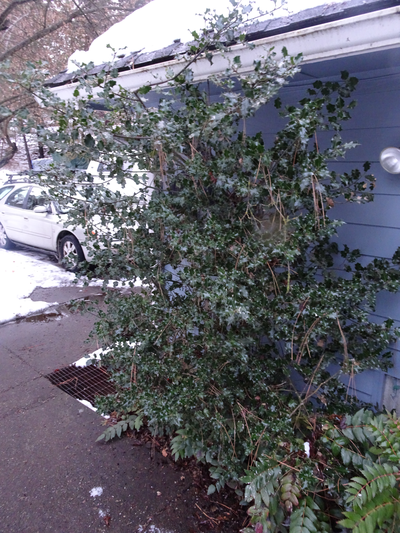Gardening: Good time to start thinking of acquiring holly plants, Munts writes

As I was shoveling last week’s snow, the Christmas carol “The Holly and the Ivy” got stuck in my head. I think it started when I startled several birds out of our English holly bush along the walk. It is close to the bird feeder, and they seem to like hiding from the weather and predators among its prickly leaves.
Yes, we are growing an English holly, a USDA Zone 7 plant, in Spokane and have for over 30 years. The trick is that it is planted tight against the north wall of the house under the sheltering branches of a maple tree. This protects it from our occasional Arctic Express winds that can – and have – winter burned the leaves but not killed the plant. In minus 20 weather we do cover it with a tarp and turn on the nearby flood light to keep it warm.
Spoiling plants this much isn’t for everyone though. There are several hollies that are hardy to our zone 5, a few lower, that would be a great addition to a garden. Hollies generally are pest and disease free and are also deer resistant with a few exceptions. They like an evenly moist, slightly acidic soil with a moderate amount of organic matter worked in at planting. The plants are bushiest in full sun and will thin out in partial shade They have a moderate growth rate with some cultivars growing just a few feet and others reaching 20 to 40 feet. Some are evergreen while others are deciduous, but all can be easily pruned to maintain their shape. Holly plants are dioecious so if you want the red berries you must plant a male to pollinate the female plant.
Many of the native American hollies or cultivars that have been crossbred with them are hardy to at least zone 5. Winterberry or Christmas berry (Ilex verticillate) is native to the eastern U.S. It is a deciduous shrub that grows to 6 to 10 feet tall and wide producing masses of berries that can range from bright red to orange depending on the cultivar.
The blue hollies (cross of I. rugosa and I. aquifolium) include over a dozen cultivars characterized by lustrous blue-green foliage and a darker red berry. Blue Prince (male) and Blue Princess (female) are two popular cultivars in this group. They have a shrubby habit and can reach 12 to 15 feet with time. These are not deer resistant.
The inkberry hollies (Ilex glabra) have flat, elongated serrated leaves and black fruit. They are tolerant of heavy soils and do well in shadier parts of the garden. They will grow 6 to 8 feet tall and 4 feet wide.
If you are interested in growing hollies, now is a good time to talk to your favorite nursery to see if they are ordering any for their spring sales. Otherwise, they will readily be available online in the spring from several specialty nurseries. Order from nurseries located in the northern tier of the country to get cold tested plants.
Pat Munts has gardened in the Spokane Valley for over 35 years. She is co-author of “Northwest Gardener’s Handbook” with Susan Mulvihill. She can be reached at pat@inlandnwgardening.com.